
Radiant Silvergun is a shoot 'em up video game developed and published by Treasure. It was originally released in Japanese arcades in 1998 and subsequently ported to the Sega Saturn later that year. The story follows a team of fighter pilots in the far future who are battling waves of enemies summoned by a mysterious crystal dug up from the Earth. The player hosts an arsenal of six different types of shots to choose from, and a sword to destroy nearby targets. The stages are tightly designed to present players with scenarios that can be approached differently with the various weapon types.

Missile Command is a 1980 shoot 'em up arcade video game developed and published by Atari, Inc. and licensed to Sega for Japanese and European releases. It was designed by Dave Theurer, who also designed Atari's vector graphics game Tempest from the same year. The game was released during the Cold War, and the player uses a trackball to defend six cities from intercontinental ballistic missiles by launching anti-ballistic missiles from three bases.
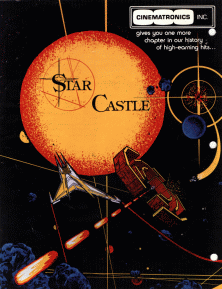
Star Castle is a vector graphics multidirectional shooter released in arcades by Cinematronics in 1980. The game involves obliterating a series of defenses orbiting a stationary turret in the center of the screen. The display is black and white with the colors of the rings and screen provided by a transparent plastic screen overlay.

Star Wars is a first-person rail shooter designed by Mike Hally and released as an arcade video game in 1983 by Atari, Inc. It uses 3D color vector graphics to simulate the assault on the Death Star from the 1977 film Star Wars. There are three connected gameplay sequences: combat against TIE fighters in space, flying across the surface of the Death Star, and the final trench run. The sequence repeats with added complications and the Death Star regenerating for each. The player's X-Wing fighter has a shield which only protects against damage a certain number of times, then the next hit ends the game. Speech synthesis emulates actors from the film.

RayForce is a vertically scrolling shooter by Taito for the Taito F3 arcade hardware and released in 1994. It was ported to the Sega Saturn in 1995, Microsoft Windows in 1997, then rereleased for iOS in 2012 and Android in 2017.

Virtual On: Cyber Troopers is a 1996 video game developed and published by Sega. A 3D shooting and fighting game featuring robots, it was released in arcades and for Sega Saturn and PC, in both America and Japan. There were also two-player online versions of the game released in America and Japan for the Sega Saturn using the NetLink and XBAND services. Initially the game was to be released under the title "Virtual On" in Japan and "Cyber Troopers" in North America, but ultimately these two names were combined into a single title for both regions.
Blaster is a first-person rail shooter video game, released for arcades by Williams Electronics in 1983. It was developed by Eugene Jarvis and Larry DeMar. A vague sequel to Robotron: 2084, the game is a shoot 'em up set in outer space. The goal is to destroy enemies, avoid obstacles, and rescue astronauts in twenty levels, to reach paradise.
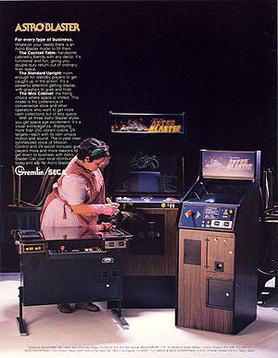
Astro Blaster is a space-themed fixed shooter released in arcades by Sega in 1981. It was designed and programmed by Gary Shannon and Barbara Michalec. The game uses speech synthesis and during attract mode a voice says "Fighter pilots needed in sector wars...play Astro Blaster!" It is the first video game to have a copyright registered in Japan.

Space Fury is a 1981 multidirectional shooter arcade game developed by Gremlin. Sega/Gremlin released the game in North America in June 1981, and then Sega released it in Japan in July 1981. It is the first game with color vector graphics, and it was Sega's second game to use speech synthesis. Coleco published a ColecoVision version with raster graphics in 1983.
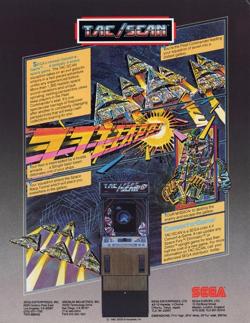
Tac/Scan (夕ック/スキャン) is a space combat shooter released as an arcade video game in 1982. It was developed by Sega Electronics and published by Sega. An Atari 2600 version was released in 1983.
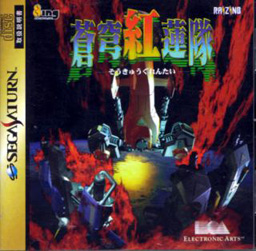
Sōkyūgurentai, also known as Terra Diver, is a vertical-scrolling shooting game by Raizing originally released as an arcade game for the ST-V platform in 1996. The game was ported to the Sega Saturn and PlayStation in 1997, with neither port being released outside of Japan.
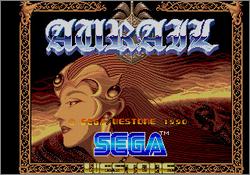
Aurail is a scrolling shoot 'em up arcade game developed by Westone and released by Sega in 1990. The player pilots a tank mecha and shoots enemies, collects power-ups to increase shields, operates the remote attack drone, and defeats bosses to advance levels. It features tunnel levels with a first-person view.

B-Wings is a vertically scrolling shooter first released as an arcade video game by Data East in 1984. A version was released in 1986 for the Family Computer. It was Data East's very first home release for the console.
Pleiades (プレアデス) is a fixed shooter arcade game released in 1981 by Tehkan and licensed to Centuri. The name is shown on the title screen as Pleiads. The title comes from the mythical Greek Pleiades, the seven daughters of the titan Atlas.

Moon Cresta is a fixed shooter video game released by Nichibutsu for arcades in 1980. In North America, it was licensed to Sega/Gremlin and Centuri, the latter releasing it in arcades as Eagle. Incentive Software published ports of Moon Cresta for the Amstrad CPC, Commodore 64, Dragon 32 and ZX Spectrum home computers. In 2022, the original arcade version will be included as part of the Sega Astro City Mini V, a vertically-oriented variant of the Sega Astro City mini console.
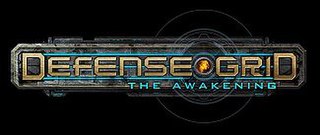
Defense Grid: The Awakening is a tower defense video game developed by Hidden Path Entertainment for Windows and Xbox Live Arcade on the Xbox 360. The game was one of the titles promoted by Microsoft during their Game Developers Conference keynote speech on February 20, 2008. The game was released for Microsoft Windows on December 8, 2008, and for Xbox 360 on September 2, 2009. The OS X version shipped from Virtual Programming on July 7, 2010.

Space Firebird is a 1980 arcade video game developed by Nintendo R&D1 and released by Nintendo in Japan and Europe. In America, the game was distributed by Far East Video. Sega-Gremlin also released a version of the game in North America.

Bloodshot, also released as Battle Frenzy in Germany, is a video game developed by Jim Blackler for Domark in 1994 for the Mega Drive and the Mega-CD in Europe. A North American release was planned, and reviewed in gaming magazines, but was only released through the Sega Channel service.

Gunblade NY is a light gun rail shooter developed by Sega for the Model 2 arcade machine and was released in 1995 in North America and 1996 in Japan. The game was re-released alongside its sequel, L.A. Machineguns: Rage of the Machines for the Wii in 2010 as part of the Sega Arcade Hits Pack.

Space Zap is a space-themed fixed shooter arcade video game developed by Game-A-Tron and licensed to Midway Manufacturing in 1980. The player controls the defenses of an immobile base in the center of the screen which is attacked from the top, bottom, left, and right. Pressing one of four oversized buttons moves the gun in the corresponding direction. A fifth button fires. Space Zap shipped in three form factors: standard upright, cocktail, and Bally's Mini-Myte reduced size cabinet.

















